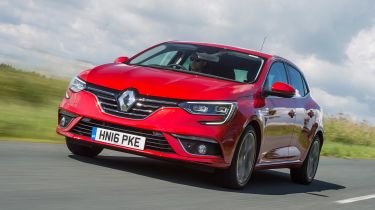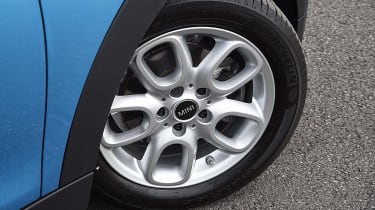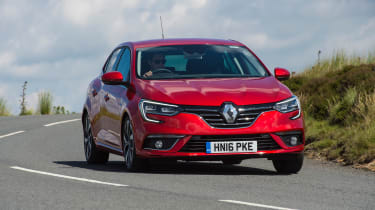New Renault Megane diesel 2016 review
New diesel-powered Renault Megane is stylish and comfortable, but can it keep up with the class best?

We’ve waited almost nine months to drive the new Renault Megane in the UK, and improvements across the board mean it's right up there challenging the segment leaders for class honours. It looks great, rides well and comes packed with kit, and while a SEAT Leon is better to drive, the Megane offers a compelling all-round package.
We first drove the new Renault Megane back in November last year. However, the need to prioritise left-hand drive models for the home markets meant we’ve had to wait until now to deliver our final verdict on UK cars.
Our first taste on European soil came courtesy of Renault’s flagship Megane GT. It’ll sit atop the range until an even feistier Honda Civic Type R rival touches down at some point in 2018. Here though, we’ve been gifted the more modest dCi 110 in well-equipped Dynamique S Nav trim.
It’s this very model that Renault bosses expect to account for the majority of sales. The familiar diesel engine is lifted unchanged from the Kadjar crossover, with 108bhp and 260Nm of torque. Our car came fitted with a six-speed manual gearbox, though a seven-speed EDC dual clutch is available as a £1,200 option.
The new Megane certainly looks the part. It stands out like no car in its class and makes the old model look instantly out of date. The neat C-shaped LED daytime running lights, sharp body creases and unique rear light signature give it a degree of road presence missing elsewhere in this segment. Our car’s Flame Red paint looked radiant in the summer sunshine, too.
Used - available now

2020 Skoda
Octavia Estate
55,446 milesAutomaticPetrol1.5L
Cash £12,600
2018 Volkswagen
Golf GTD
101,000 milesManualDiesel2.0L
Cash £12,300
2014 Volkswagen
Polo
65,000 milesManualPetrol1.2L
Cash £20,600
2016 Tesla
Model S
78,000 milesAutomaticElectric
Cash £18,999In the cabin, Renault has transferred much of its expertise from D-segment models like the not-for-UK Espace and Talisman saloon. That means you get the same portrait-oriented touchscreen on higher-spec cars, as well as a seven-inch display between the dials. Everything is configurable, meaning you can decide which apps or functions to prioritise on the home screen. The display is remarkably responsive and the TomTom sat-nav is easy to use, while things like the climate control and screen heater are easily accessible via a subtle row of buttons. The centre console looks great and trumps anything currently available from the VW Group.
But while the top of the dashboard and doors are coated in soft-touch plastics, it doesn’t take long to uncover some scratchier materials on the side of the transmission tunnel and toward the footwells. It doesn’t feel as solid as a Vauxhall Astra inside, though it’s easily on a par with Korean rivals like the Hyundai i30 and Kia Cee’d.
All cars come well equipped, and Renault claims this new car offers best in class service, maintenance and repair costs. This has allegedly contributed to an eight per cent rise in residual values across the board, over any like-for-like predecessors. Expression+ models get LED daytime ruuning lights, alloy wheels and air-con, while Dynamique Nav versions add a touchscreen, dual zone climate control and rear parking sensors. Move your way through the trims and you’ll add things like a reversing camera and leather upholstery, while every new Megane comes with a five-star Euro NCAP crash test rating.
Under the bonnet you’ll find a choice of two petrol and two diesel engines. Our dCi 110 is an eager performer, with a decent 108bhp making light work of short urban journeys and longer motorway jaunts. It’s pleasingly refined at 70mph, while the standard-fit 17-inch diamond-cut alloy wheels on our mid-spec test car ensured it rode well without much in the way of road noise. There’s a slight whistle around the mirrors at higher speeds, but that quickly fades with the radio switched on.
The steering is light, which makes parking around town simple and straightforward. It’s not totally devoid of feel, but the Megane could still learn a thing or two from rivals like the SEAT Leon, which manage to better mix manoeuvrability with driver fun. Switch the now familiar Multisense button (standard on Dynamique Nav and above) to Sport and things weight up, but it does little to endow any sense of athleticism.
That said, if you’re prepared to work the gears, there’s plenty to be had from this entry-level diesel. In our experience, the extra cost of the dCi 130 is hard to justify for the tiny performance gains, with this 110 offering suitable shove from low revs. It tails off towards the red line, but competitor cars suffer a similar fate. A punchier dCi 165 will join the range later, but we’ll reserve judgement on that until we’ve driven all three back-to-back.
But what it lacks in outright handling, it makes up for at the pumps. Our car – on those 17-inch wheels – emits an impressive 96g/km of CO2 and will return 76.4mpg, while even the EDC automatic model slips under the magic sub-100g/km barrier. This further cements the dCi 110 as the engine of choice, as buyers of the dCi 130 will not only travel fewer miles per gallon of fuel, they’ll also pay more company car tax and suffer a £20 fee for annual VED. A Ford Focus ECOnetic is even more frugal, but is six-tenths of a second slower from 0-62mph.










